Artistic Lines
from Joan Justis
August 2016
joanjustis.com
Illuminate the Text!
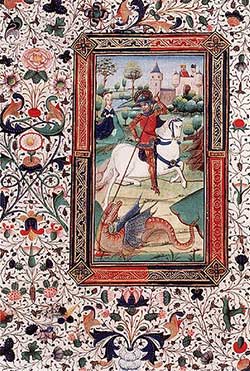
Page from 15th Century Breviary
The name “illuminated manuscripts” is derived from the Latin verb
illuminare which translated means
to light or
enlighten. Very fitting, since the beautiful gold and silver leaf enhanced drawings do both for the text of the page. I pour over the exquisite patterns that surround the text-so delicate and colorful, obviously a labor of love.
The artisan stretched and scraped an animal skin until thin enough to be cut into parchment pages that would eventually be sewn into
gatherings and given two pieces of leather covered wood for the cover. Lines were drawn on the pages with a quill pen for the scribe to align the text. Drawings were sketched in ink, and painted with egg tempera. Gold and silver leaf were glued on and burnished till the illustration was filled with light.
The above illumination is from a Catholic Breviary (brief book) used by the Divine Office for prayers, readings and hymns during the 15th Century. It can be found in the National Library of the Netherlands.
I have since learned that such drawings are preserved in many cultures.
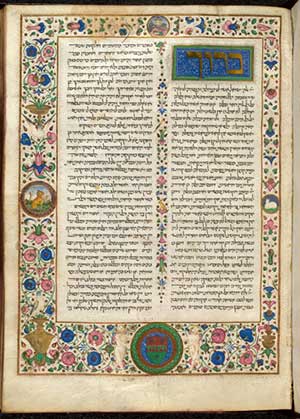
Illuminated page from a 15th century breviary
This is the frontispiece to a Hebrew book which is the second of the four pillars of
Arbaah Turim, Yore Deah (Teaching Knowledge) found in the British Library Catalogue. The parchment is dated 1475 and is signed by Hayyim Barbut as the scribe. The artists were Florentine. It became a collector’s item and was finally sold for £10,000 to the British government in 1753 to be placed in the new British Museum.
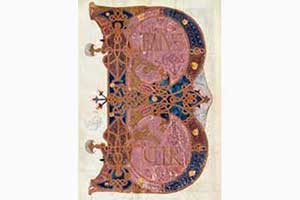
Book of Prayers created for Ferdinand I of Spain during 11th century
This beautiful image is taken from a Prayer Book or Book of Hours created in Spain for Ferdinand I of Leon during the 11th Century. It is in the Library of the University of Santiago de Compostela.
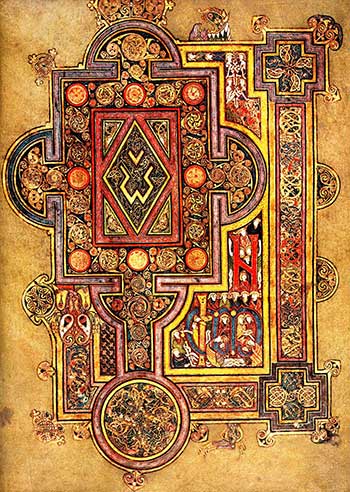
Page from the Celtic Book of Kells 800 AD
The Book of Kells was created in the 800’s in a Celtic monastery on an island near Scotland. It contains the four gospels of the New Testament copied from the Vulgate bible. The vellum (parchment) pages are lavishly decorated with Celtic knots, animals, and human figures as Christian symbols.
The Art Minute tells us that it took four scribes, three illuminators, and 185 calf skins. The four volume masterpiece is displayed in the Trinity College Library in Dublin.
In 1450-55 the Gutenberg Press pre-empted hand copied books and the art of illuminated manuscripts began to disappear. However, the Ottoman Empire outlawed the use of the press and they continued to produce manuscripts for another hundred years.
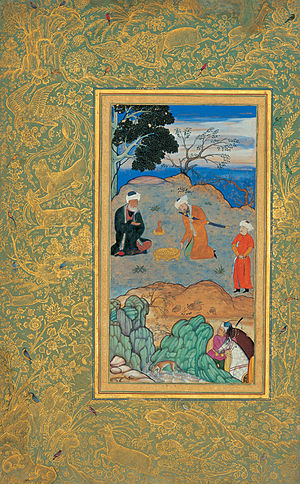
Persian illuminated text entitled Advice Ascetic 1500-1550
This is a Persian miniature, an art form of the Ottoman Empire. It was kept in a private album called a
muraqqa. It is “Advice of the Ascetic” by Behzad circa 1500-1550. There is Chinese influence as a result of the Mongol invasion.
It is so remarkable that these beautiful books have been preserved for hundreds of years. These manuscripts are exquisite and demand admiration and respect for the skill, commitment, and patience of the creator. I am inspired to adapt the patterns and composition for this years’ Nativity Celebration piece! Watch my progress on Instagram
joanjustisstudios and on Facebook
Joan Justis Fine Art.
RESOURCES
publicdomainreview.org/collections/illuminated-pages-from-15th-century-breviaries/
http://www.getty.edu/art/exhibitions/making
the-art-minute.com/book-of-kells
http://www.bl.uk/catalogues/illuminatedmanuscripts/record.asp?MSID=19204&CollID=8&NStart=5716
http://www.facsimilefinder.com/facsimiles/ferdinand-i-book-of-hours-facsimile
https://en.wikipedia.org/wiki/Persian_miniature